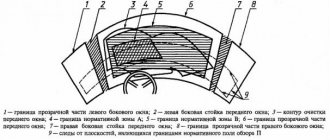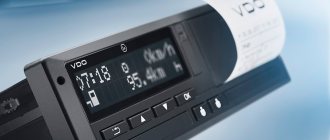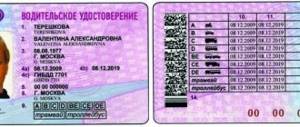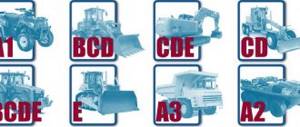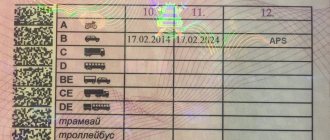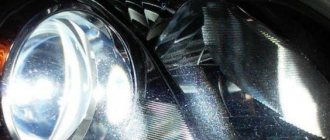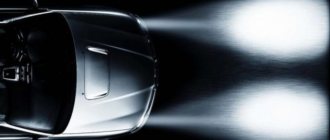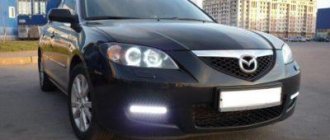Home / Autolight
Back
Published: 02/28/2021
Reading time: 6 min
0
289
- Why do you need headlight markings?
- How to correctly decipher the markings What does the marking mean?
- Halogen
Headlight markings are always on the back or side of the housing. After studying it, you can find out all the necessary information - from the production date to the type of lamps installed. There is also information about the state that issued permission for the production of headlights, the direction of movement and other characteristics regarding the equipment.
Headlight markings by category
A marking is a clear, indestructible symbol of international approval, where you can find information about the country that gave the approval, the category of the headlight, its number, the type of lamps that can be installed in it, and so on. Another name for marking is homologation, a term used in professional circles. As a rule, markings are applied to the lens and headlight housing. If the lens and headlight are not included in the kit, then the corresponding markings are applied to its protective glass.
Now let's move directly to the description of the types of headlights. So, they come in three types:
- headlights for traditional incandescent lamps (nowadays they are becoming increasingly rare);
- headlights with halogen lamps;
- headlights for xenon bulbs (aka gas discharge lamps/headlights);
- diode headlights (another name is ice headlights).
Incandescent lamps . The letter C indicates that they are intended for low beam, the letter R means high beam, the combination of letters CR means the lamp can emit both low and high beam, the combination C/R means that the lamp can emit either low or high beam (Rules UNECE No. 112, GOST R 41.112-2005).
Halogen lamps . The combination of letters HC means that it is a low beam lamp, the combination HR means that it is a lamp for high beam, the combination HCR means that the lamp is both low and high beam, and the combination HC/R is a lamp for either low beam or high beam (UNECE Regulation No. 112, GOST R 41.112-2005).
Xenon (gas discharge) lamps . The combination of letters DC means that the lamp is designed to emit low beam, the combination DR means that the lamp emits high beam, the combination DCR means that the lamp is both low and high beam, and the combination DC/R means that the lamp is either low or high beam (Rules UNECE No. 98, GOST R 41.98-99).
The HCHR marking on Japanese cars means HID C Halogen R, that is, low beam xenon, high beam halogen.
Since October 23, 2010, it is officially permitted to install xenon headlights on a car. However, it is necessary to have a headlight washer and auto-corrector. At the same time, it is desirable that employees of state traffic police agencies make appropriate notes about the features introduced into the design of the vehicle in the “special notes” column of the STS/PTS.
The best lamps for cars
Find out which bulbs to install in your car's headlights. Ratings are given for popular lamps in h1, h4 and h7 sockets. The lists are compiled based on measurements of the physical indicators of lamps and their characteristics Read more
Optics for xenon
The markings on xenon headlights consist of the following letters:
- DC,
- D.R.
- DC/R.
The first letters D indicate the use of gas-discharge sources in conjunction with lenses or special reflectors.
It is not recommended to independently install xenon in foglights and headlights with codes HC, HR, HC/R. This can not only harm the car's wiring, but also damage the reflector. The use of xenon is also prohibited in taillights.
International approval marks
All licensed lamps installed in modern cars have certain certification. The most common standards are the following: the letter “E” corresponds to the European standard, the abbreviation DOT (Department Of Transport - Department of Transport of the United States of America) is the first American standard, the combination SAE (Society Of Automotive Engineers) is another standard according to which , including motor oils.
When marking headlights, just like when marking lamps, a specific number is used to designate countries. The relevant information is summarized in a table.
| Number | The name of the country | Number | The name of the country | Number | The name of the country |
| 1 | Germany | 13 | Luxembourg | 25 | Croatia |
| 2 | France | 14 | Switzerland | 26 | Slovenia |
| 3 | Italy | 15 | not assigned | 27 | Slovakia |
| 4 | Netherlands | 16 | Norway | 28 | Belarus |
| 5 | Sweden | 17 | Finland | 29 | Estonia |
| 6 | Belgium | 18 | Denmark | 30 | not assigned |
| 7 | Hungary | 19 | Romania | 31 | Bosnia and Herzegovina |
| 8 | Czech Republic | 20 | Poland | 32…36 | not assigned |
| 9 | Spain | 21 | Portugal | 37 | Türkiye |
| 10 | Yugoslavia | 22 | Russian Federation | 38-39 | not assigned |
| 11 | Great Britain | 23 | Greece | 40 | Republic of Macedonia |
| 12 | Austria | 24 | not assigned | — | — |
Most headlights also have the logo of the manufacturer or brand under whose sign this or that product was produced. Similarly, the location of the manufacturer is indicated (often this is simply the country where the headlight was manufactured, for example, Made in Taiwan), as well as the quality standard (this can be either an international standard, for example, ISO, or internal quality standards of that or other specific manufacturer).
Decoding
The first letter in the code indicates that the optics comply with the quality standard for a particular region.
International approval marks for lighting devices
The letter E indicates that the headlight meets the optical equipment standards adopted for European and Japanese cars.
SAE, DOT - indicates that the headlight meets the standard adopted by the American Technical Inspection for Automotive Optics in the United States.
The number after the first letter indicates the country of manufacture or the state that issued approval for the use of this class of optics. The approval certificate guarantees the safety of a specific model for use on public roads within the established modes (daytime running lights, high beam, low beam, etc.).
The table below provides a short list of country compliance.
| Code digit | A country | Code digit | A country |
| 1 | Germany | 12 | Austria |
| 2 | France | 16 | Norway |
| 3 | Italy | 17 | Finland |
| 4 | Netherlands | 18 | Denmark |
| 5 | Sweden | 20 | Poland |
| 7 | Hungary | 21 | Portugal |
| 8 | Czech | 22 | Russia |
| 9 | Spain | 25 | Croatia |
| 11 | Great Britain | 29 | Belarus |
In the international marking of automobile headlights, the following combinations of symbols are adopted, which determine the type and location of the headlight unit, lamp class, beam range, and flow power.
According to functionality and operating parameters, the optics are marked with the following symbols:
- A – head optics;
- B – fog lights;
- L – license plate illumination;
- C – headlight for low beam bulbs;
- RL – daytime running lights;
- R – block for high beam lamps.
If the headlight unit fits universal lamps with built-in switching for high/low beam, the following combinations are used in the code:
- HR – high beam must be provided by a halogen lamp.
- HC/HR – the headlight is designed for halogens, the unit has two modules (sockets) for low and high beam lamps. If this HC/HR marking is used on a headlight from a Japanese manufacturer, then it can be converted to use xenon lamps.
Type of light emitted
Typically, information about the type of light emitted is indicated somewhere in the immediate vicinity of the circled symbol. So, in addition to the above types of radiation (halogen, xenon, LED), there are also the following designations:
- Letter L. This designates the light sources for the rear license plate of a car.
- The letter A (sometimes combined with the letter D, which means that the homologation refers to a pair of headlights). The designation corresponds to front marker lamps or side lamps.
- The letter R (similarly, sometimes in combination with the letter D). This is the designation for the rear parking light.
- Combinations of characters S1, S2, S3 (similarly, with the letter D). This is how brake lights are designated.
- Letter B. This is how the front fog lights are designated (in Russian designation - PTF).
- Letter F. The designation corresponds to the rear fog lamp, which is mounted on cars, as well as towbars.
- Letter S. The designation corresponds to an all-glass headlamp.
- Designation of the front turn signal 1, 1B, 5 - side, 2a - rear (they emit orange light).
- Turn signals also come in a transparent color (white light), but they shine orange due to the orange lamps inside.
- AR symbol combination. This is how reversing lights installed on cars and trailers are marked.
- Letters RL. This is how fluorescent lamps are marked.
- Combination of letters PL. These symbols correspond to headlights with plastic lenses.
- 02A - this is how the sidelight (size) is designated.
It is interesting that cars intended for the North American market (United States of America, Canada) do not have the same designations as European ones, but they do have their own. For example, turn signals on American cars are usually red (although there are others). The symbol combinations IA, IIIA, IB, IIIB are reflectors. Symbol I corresponds to reflectors for motor vehicles, symbol III corresponds to towed devices, and symbol B corresponds to built-in headlights.
According to the rules, side marker lights must be installed on American cars longer than 6 meters. They are orange in color and designated SM1 and SM2 (for passenger cars). The rear lights emit a red light. On trailers it is necessary to install a triangular reflector, designated IIIA, and contour lights.
Often the information plate also contains information about the initial angle of inclination at which the low beam should be scattered. Most often it is within 1...1.5%. In this case, there must be a tilt angle corrector, since with different loads of the car, the angle of illumination of the headlights also changes (roughly speaking, when the rear of the car is heavily loaded, the main luminous flux from the headlights is directed not at the road, but directly in front of the car and even slightly upward ). In modern cars, as a rule, this is an electronic corrector, and they allow you to change the corresponding angle directly from the driver’s seat while driving. In older cars, this angle must be adjusted directly in the headlight.
Some headlights indicate the SAE or DOT standard number (European and American automaker standards).
Main differences
At first glance, it is not clear that these headlights are completely different, but if you are faced with the need to replace any of the headlights, you run the risk of purchasing a model that is completely unsuitable and will differ from the second headlight.
BOSCH or Kirzhach
Difference between Bosch and Kirzhach headlights:
- To replace the light bulb in the main lighting, you need to disconnect the black circle-shaped housing under the hood on the Bosch headlight. In the Kirzhach headlight, the casing is rectangular and secured with two screws.
- The headlights differ in the glass pattern; in addition, each of them has a manufacturer's mark. The Bosch package includes a glass frame; replacing it does not require complete disassembly of the headlight.
- There are also differences in the mounting of the turn signals. The Kirzhach turn signal is equipped with two fasteners, has a central latch and a spring tensioner. The Bosch turn signal is also equipped with two fasteners and a spring tensioner, but does not have a latch. This indicates that the turn signal from one company cannot be replaced with a model from another company; interchangeability is completely excluded.
- The reflector also has significant differences. The Kirzhach company has a narrow and long reflector with an internal partition that divides the light beam in half. Moreover, there is no upper wall in the reflector. The Boshevsky reflector is shorter and wider in shape; all walls of the model are equipped with it.
Considering the more balanced and high-quality Bosch reflector, the light of the model is brighter and more saturated, unlike the opponent’s model. Also, to achieve a greater effect, it is possible to replace the lamp with a better one, and it is necessary to carry out an adjustment procedure.
Illuminance value
All headlights have a symbol indicating the maximum luminous intensity (in lux) that a headlight or pair of headlights can produce. This value is called the leading base number (abbreviated as leading base number). Accordingly, the higher the VOC value, the more intense the light emitted by the headlights and the greater the range of its propagation. Please note that this marking is only relevant for headlights that have both low and high beams.
In accordance with current standards and regulations, all modern manufacturers are not allowed to produce headlights with a leading base number value exceeding 50 (corresponding to 150 thousand candelas, cd). As for the total total light intensity emitted by all headlights installed on the front of the car, it should not exceed a VOC equal to 75, or 225 thousand candelas. Exceptions include headlights for special equipment and/or closed sections of roads, as well as sections significantly removed from sections of the road used by ordinary (civilian) transport.
Conclusion
Perhaps you have already decided for yourself which headlights are better for the VAZ 2114, Kirzhach or Bosch. But let's go through all the positions again, so:
- We found out that Bosch headlights have a much brighter and more saturated light, unlike the opponent’s models.
- Kirzhach headlights can be modernized yourself, changes can be made using the method you need. But it is important to note that not all drivers are ready to spend time altering their headlights, even for the better. Again, there are exceptions to the general rule; there are motorists who are ready to constantly improve the technical characteristics of their car, even if it concerns headlights.
- The price indicator of the Bosch company is slightly lower, in contrast to the opponent's company.
Here are three main points that distinguish these models from each other: it’s up to you to decide whether Kirzhach or Bosch is better.
Direction of movement
This marking is relevant for cars with right-hand drive, that is, for those that were originally intended for driving on roads with left-hand traffic. This function is marked with arrows. So, if in the symbol on the headlight there is an arrow pointing to the left, then, accordingly, the headlight should be installed in a car designed to drive on roads with left-hand traffic. If there are two such arrows (directed both to the right and to the left), then such headlights can be installed on cars for roads with both left-hand and right-hand traffic. True, in this case additional adjustment of the headlights is necessary.
However, in most cases, the arrows are simply missing, which means that the headlight must be installed on a car designed to drive on right-hand drive roads. The absence of an arrow is due to the fact that there are more right-hand traffic roads in the world than left-hand ones, and the same applies to the corresponding cars.
What bulbs to put in the headlights of VAZ 2109, 2112, 2114, 2115
Owners of domestic cars in most cases are faced with the problem of a lack of lighting from those bulbs in the headlights that are installed by the manufacturer. Typically, the VAZ company equips its models with Philips + 30% bulbs. These lamps are of fairly high quality and provide a clear demarcation line on the road. But if these properties are not enough for the car owner, then there are many options for replacing headlight paws.
Official approval
Many (but not all) headlights contain information about the standards to which the product meets. Moreover, this depends on the specific manufacturer. As a rule, information about standardization is located under the symbol within the circle. Usually information is stored in a combination of several numbers. The first two of them are the modifications that this headlight model has undergone (if any, otherwise the first digits will be two zeros). The remaining numbers are the individual homologation number.
Homologation is an improvement of an object, improvement of technical characteristics in order to comply with any standards or requirements of the consumer country of the product, obtaining approval from an official organization. Homologation has very rough synonyms “accreditation” and “certification”.
Many car enthusiasts are interested in the question of where exactly they can look up information about the labeling of new or already installed headlights on their car. Most often, the relevant information is applied to the upper part of the headlight housing, in particular, under the hood. Another option is that the information is printed on the inside of the headlight glass. Unfortunately, for some headlights the information cannot be read without first removing the headlights from their mounting location. This depends on the specific car model.
What is the marking for and what does it mean?
First of all, the markings on the headlamp help the driver decide what type of light bulbs can be installed to replace burnt ones. In addition, the label contains a large amount of additional information: from the year of manufacture to the country of certification, as well as information about compliance with standards.
Car headlight markings
According to the international standard (UNECE Rules N99/GOST R41.99-99), optical equipment installed on wheeled vehicles (cars) must be marked according to an approved model.
The code, which contains letters of the Latin alphabet, deciphers all the information about the car headlight:
- the type of lamps intended for installation in a specific unit;
- model, version and modification;
- category;
- lighting parameters;
- direction of the light flux (for the right and left sides);
- the country that issued the certificate of conformity;
- date of manufacture.
In addition to the international standard, some companies, for example, Hella and Koito, use individual markings that indicate additional equipment parameters. Although their standards do not contradict international rules.
The marking is melted onto a plastic sidelight and duplicated on the back side of the body under the hood in the form of a sticker. The protected sticker cannot be removed and reinstalled on another product without damage, so low-quality optics often do not have full markings.
Xenon headlight markings
In recent years, xenon headlights have become very popular among domestic car enthusiasts. They have a number of advantages over classic halogen light sources. They have a different type of base - D2R (the so-called reflector) or D2S (the so-called spotlight), and a glow temperature below 5000 K (the number 2 in the designation corresponds to the second generation of lamps, and the number 1, respectively, to the first, but they are currently found infrequently for obvious reasons). Please note that the installation of xenon headlights must be carried out correctly, that is, in accordance with current rules and regulations. Therefore, it is better to install xenon headlights in a specialized auto repair shop.
The following are specific designations for halogen headlights, with the help of which it is possible to determine whether xenon light can be installed instead:
- DC/DR. This headlight has separate low and high beam sources. Moreover, such designations can also occur on gas-discharge lamps. Accordingly, instead of them you can put “xenon lights”, but in accordance with the rules mentioned above.
- DC/HR. Such headlights are designed to install gas-discharge lamps for low-beam lighting. Accordingly, such lamps cannot be installed on other types of headlights.
- HC/HR. This marking is installed on the headlights of Japanese cars. It means that instead of halogen headlights, xenon ones can be mounted on them. If a similar inscription is on a European or American car, then the installation of xenon headlights on them is prohibited! Accordingly, only halogen headlights can be used for them. Moreover, this applies to both low and high beam lamps.
Sometimes numbers are written before the characters mentioned above (for example, 04). This number indicates that changes have been made to the documentation and design of the headlights in accordance with the requirements of the UNECE Regulations with the number indicated before the mentioned symbols.
As for the places where information about the headlight is printed, xenon light sources can have three of them:
- directly on the glass from its inside;
- on top of the headlight cover, made of glass or plastic; to study the relevant information, it is usually necessary to open the hood of the car;
- on the back of the glass cover.
Xenon lamps have a number of individual designations. Among them are several English letters:
- A - lateral;
- B - anti-fog;
- C — low beam;
- R - high beam;
- C/R (CR) - for use in headlights as sources of both low and high beam.
Sticker for xenon headlights
Samples of various stickers
Recently, among car enthusiasts whose cars are equipped with xenon headlights not from the factory, but during operation, the topic of making headlight stickers on their own is gaining popularity. In particular, this is true for xenon lenses that have been altered, that is, normal xenon lenses have been replaced or installed (for optics without changes, the corresponding sticker is made by the manufacturer of the headlight or car).
When making stickers for xenon headlights yourself, you must know the following parameters:
- What kind of lenses were installed - bilens or regular mono.
- The bulbs used in the headlight are for low beam, high beam, turn signal, running lights, type of base, and so on. Please note that for Chinese Plug-n-play lenses, you cannot indicate the Chinese lens and halogen base (type H1, H4 and others) on the sticker. Also, when installing them, it is necessary to hide their wiring, since by their appearance (installation) you can easily identify such devices, and get into trouble when checked by employees of the State Road Service.
- Geometric dimensions of the sticker. It must fit completely on the headlight housing and provide complete information when looking at it.
- Manufacturer of headlights (there are a lot of them nowadays).
- Additional information, such as the production date of the headlights.
General information
If the headlights are not designed for xenon, then it will not be possible to install this type of lamp in them, since this is fraught with violation of the law and the issuance of a report from the traffic police inspector.
In addition, failure to comply with labeling requirements can lead to poor lighting quality, because headlights not intended for this purpose cannot ensure the normal operation of xenon and the concentration of the light emitted by it, which is necessary for the effective use of such lighting devices.
Marking is the designation of headlight features, expressed in letters and numbers, which tell the consumer what can be mounted in this optics so that it performs its tasks as efficiently as possible, without interfering with other motorists.
Marking is useful for craftsmen who immediately understand which lamps can be used in it and which additional devices may well be used to ensure operability.
Initial data
Different countries may have different labels that look the same but carry different information.
For example, in Japan the HC/HR marking is used - the same as in European cars, but if in an Asian country this means the headlight is suitable for xenon in low and high range modes, then in European cars such a designation will be a complete ban on xenon lamps and their intended purpose headlights are strictly for halogen lamps.
Therefore, if the car is Japanese, but is used in European countries, in particular in Russia, then you need to have with you certain documents explaining the meaning of the marking.
You should not ignore the markings on the headlights, because if its requirements are violated, you may not only not get high-quality light, but also dazzle other drivers, which is not only unpleasant, but also dangerous, since it creates an emergency situation and can provoke a real tragedy.
Their design
The glow of a headlight is created thanks to several specific elements, the most important of which is the light source itself in the form of a lamp, which shines in all directions, directing particles around itself.
The task of collecting light into a beam is taken care of by a reflector, which receives all the rays and directs them in a certain direction, amplifying them many times over.
At the same time, there is also a corrector for the xenon headlight, which limits the light zone, directing the beam forward.
There is also a difference in a xenon headlight, which is the actual absence of a diffuser; there is glass, but it is polished and does not have the functions that are needed, for example, for halogen or incandescent lamps, the light of which must be diffused for normal illumination.
The xenon lamps themselves are made in the form of a flask containing two electrodes, and its internal space itself is filled with a noble inert gas - xenon.
We recommend: A proven method for repairing an engine without disassembly
When the light bulbs are turned on, the ignition unit, which is located separately from the light bulb, is triggered and produces a voltage of 25 thousand volts through the wires, which enters the flask, and at the same time the gas begins to glow, and its light is directed in the desired direction using a corrector.
The legislative framework
Regarding xenon and compliance with labeling, there are Rules for the operation of vehicles, which regulate that the vehicle must use exactly those devices that are structurally provided for in it.
The same applies to individual technical elements, including headlights. Thus, when a headlight that is not intended for xenon and does not have the appropriate marking contains a xenon lamp, this is a violation of established standards.
But the 2021 law does not stipulate the marking of xenon on headlights, since this has not been adopted.
But a person who was noticed operating a car in which the lighting devices do not correspond to the markings or they were even replaced without coordination with the technical authorities of the traffic police risks being punished.
This is evidenced by the Code of Administrative Offenses of the Russian Federation and its Article 12.5, which even provides for deprivation of rights if the presence of light bulbs not intended for this device is proven by technical experts.
Anti-theft headlight markings
Like windshields, car headlight lenses are also marked with a so-called VIN code, the purpose of which is to identify a specific glass in order to minimize the risk of theft of the headlight. This is especially true for expensive foreign cars from world-famous manufacturers, the cost of headlights of which is quite high, and either there are no analogues or they also have a considerable price. Typically, the VIN is engraved on the headlight housing. Identical information is entered into the technical documentation of the vehicle. Accordingly, when checking the vehicle configuration of a traffic police officer, if the code value does not match, they may have questions for the car owner.
The VIN code itself is a seventeen-digit code consisting of letters and numbers, and is assigned by the car manufacturer or the manufacturer of the headlight itself. This code is also duplicated in several places on the car body - in the cabin, on the nameplate under the hood, under the windshield. Therefore, when purchasing certain headlights, it is advisable to choose light sources on which the VIN code is clearly visible and all information about the product is known.
International marking designation
The lighting equipment of any wheeled vehicle must be marked with an alphabetic or digital code. All auxiliary elements - ignition blockers, correctors, lenses, diffusers - are marked with certified markings in accordance with international standards 41.99-99.
The code must meet the following parameters:
- be clear, easy to read;
- be in a visible place;
- have comprehensive information about the manufacturer, the angle of the light beam, certification;
- contain a designation whose arrows indicate the month and year of production.
With the help of decoding, you can determine whether car optics were changed due to a serious accident.
International approval mark
Optical instruments from different countries differ in luminous flux, as well as in the direction of the cut-off angle. The necessary information is contained on the optics body in the form of a sticker or molding on plastic.
In the classic version, optics are marked with five main designations:
- headlight type;
- used lighting elements;
- region-specific compliance;
- intended for different directions of movement;
- manufacturer.
Manufacturers apply technical information to the bottom edge of the glass. You do not need to open the hood to view the necessary information.
How to choose the right xenon lamps?
The modern market offers a wide range of gas-discharge lamps produced by different manufacturers and having different characteristics, which greatly complicates the process of choosing them.
Below are the main parameters and factors that you should pay attention to before making a purchase:
- The presence of ballast - a special ignition unit for converting and increasing the discharge received from a car battery. This is not a large device that can be installed under the hood of a car; it is recommended to purchase models of the 3rd, 4th or 5th generation.
- Color temperature is the main parameter of xenon; the choice is made depending on the individual preferences of the driver. The indicator of this characteristic can vary from 3000 to 8000K, the most common models are 4300K, which allows them to be provided with normal lighting. A color temperature of 6000-7000K provides a bluish tint, and 8000K provides a violet color with low brightness, 5000K provides a white color with increased brightness, 3500K is used for installation in fog lamps. The listed varieties allow you to ensure the beauty of lighting or its practicality; the choice is up to the driver.
- Bi-xenon is used for dual-mode models, which are used for low and high beam lighting. At its core, it is an electromagnetic device with a lamp moving relative to the reflectors, which increases the safety of its operation.
Recently, a new technology has appeared on the market - pseudo-xenon, which actually provides yellow-blue lighting and has nothing to do with real xenon.
Installation of LED lamps 2021 – is it possible or not?
Roughly speaking, LED lamps can be installed in headlights without any consequences from the police, but there are several nuances that need to be taken into account. LEDs are not fixed in any way in the Technical Regulations, which in turn distinguishes only four types of permitted head lighting:
- incandescent lamps in headlights;
- halogen lamps in headlights;
- xenon lamps in headlights;
- PTF.
Therefore, in fact, at the legislative level, there is no prohibiting article on the installation of LEDs in headlights , but the police and the law for some reason equate LEDs with halogen type lamps, although their design and technical components are completely different, and here attention should be paid to the markings of the lamps and headlights.
Advantages and disadvantages of xenon lamps
In recent years, more and more drivers are trying to install xenon lamps; the increase in their popularity is associated with the following positive aspects:
- High degree of security.
- Providing natural light that does not tire the eyes during prolonged movement at night.
- Long service life, it is significantly longer than most other varieties.
- Increased brightness.
- Possibility to independently select color temperature.
- Expanding the viewing angle, which reduces the risk of colliding with a sudden obstacle while driving in the dark.
Despite such impressive advantages, xenon lamps also have certain disadvantages:
- No immediate switching on, since the electric arc requires at least 1-2 seconds to warm up. This feature prevents the driver from flashing the high beams. This problem can only be solved by installing a combined type lamp, in which the type of lighting is switched by quickly pulling out a special curtain, or by simultaneously installing halogen light sources.
- There is no possibility of installation in a conventional cartridge; in some situations, serious intervention in the design of the vehicle may be required.
- High price.
- Incompatibility with some car headlights, preliminary verification of the markings is required, sanctions from the responsible authorities in case of violation of this rule.
Where are the markings found?
Manufacturer codes and all necessary information are indicated in two places. Where to look for the markings on the headlight:
- on the headlight glass;
- on the plastic housing under the hood.
On older car models, the code is found on the underside of the body. To view all the information, you must completely dismantle and turn over the light device. The designation of the car is found in the form of stickers, which come off over time, after which they cannot be restored.
Applying a sticker that does not correspond to reality and installing unspecified lamps is punishable by an administrative fine and the issuance of an order to eliminate the malfunction.
Purpose of headlights or lanterns
There are many lighting devices installed in any car, and each of them is designed to perform a specific function. Some illuminate the road, others help navigate in the fog, and others indicate the dimensions of the car. How to figure out what a particular flashlight or headlight is for? After all, their sizes and shapes are so mixed up today that it can be quite difficult to visually distinguish one from the other. Labeling will help. Let's look at the second letter:
- A – side light;
- B – fog lamp;
- C, R, CR, C/R – front headlights (see details below).
Difference between xenon and halogen lamps
The main difference is in the light source: halogen lamps are designed with an incandescent filament, while gas-discharge models use an electric arc.
The bulbs of xenon lamps are filled with a special mixture of gases; xenon has the highest concentration; the brightness of such lighting devices is much higher than that of their halogen counterparts. In addition, they create more natural lighting, which in its characteristics is closest to daylight, while halogen lamps do not have this opportunity.
Based on the information provided in the article, we can conclude that xenon lamps have many advantages when compared with analogues, which fully justifies their cost. However, you should first make sure that their installation is legal in order to pass a technical inspection of the vehicle without any problems and not pay fines.
Where do manufacturers put the markings?
Typically, the markings are located on the outer glass part of the headlights, on the top of the housing or on the back. In order to look at it, you need to open the hood and find the desired abbreviation. However, on some options everything is a little more complicated and in order to check the features of the headlight, it is necessary to remove and disassemble it.
Let's take a closer look at the remaining marking elements using a specific example. The first designation indicates the type of headlights: side (A), fog (B), low beam (C) or high beam, dual-mode optics (CR, C/R). Designation number 2 is the type of lamps used in optics. We will not dwell on this parameter in detail, since we talked about this at the beginning of the article.
The third number is a sign of compliance with international standards. If the letter E is indicated on the headlight, this marking applies to Japanese and European cars, and for American cars the SAE or DOT codes are used. Next to the designation is a number that corresponds to the code of the country of origin.
Finally, there is an arrow number 4. It helps determine the direction of movement in a certain country. If it is directed to the right, then the headlight is intended for use on roads with right-hand traffic and vice versa. There are also combined options suitable for different directions of movement.
The markings will allow you to accurately determine whether your headlights have xenon. If yes, then you are lucky and you can proceed to choosing a specific model, which we will say a few words about next.
Fog lights and xenon
It should be noted that xenon light is much easier to install in a fog lamp than in a regular one. You need to take into account the nuance, the light should be directed slightly downward, then the design will function perfectly. How are xenon headlights marked? The encoding must fully comply with GOST.
What advantages does this optics option have compared to halogen lighting? Thanks to it, it is better to see the side of the road, as the area of illumination increases. This is quite important when entering a turn, because it is on such sections of the road that you can get into an accident. Thanks to xenon lamps, you can quickly see an obstacle or a pedestrian, and, accordingly, react faster.
Xenon fog lights use different types of sockets; you need to determine which marking is best suited for a particular car. If there are no symbols on the glass, then you will have to remove the optics and see which base is needed.

